plant-thra-pall-uh-gee
Traditional Uses of Desert Plants
The plants of the Sonoran desert have a long history of human uses for food, shelter, medicine, art and religious practice. This tour features plants growing in the historic University of Arizona Joseph Wood Krutch Garden and explores their use for food, medicine, material and ritual. This purpose of this tour is to promote appreciation for the practical insights of the traditional cultures of the Sonoran desert within which native trees and plants were central to community life. In so doing, we aim to preserve this wisdom and encourage respect and greater consideration for the natural world in modern communities by those who live or will live here in future generations.
Begin this self-guided tour by locating the bronze interpretive sign on the northeast corner of the Joseph Wood Krutch garden on the UA Mall. The Krutch Garden is just south of the Administration Building. Locate the Administration Building using the Campus Map.
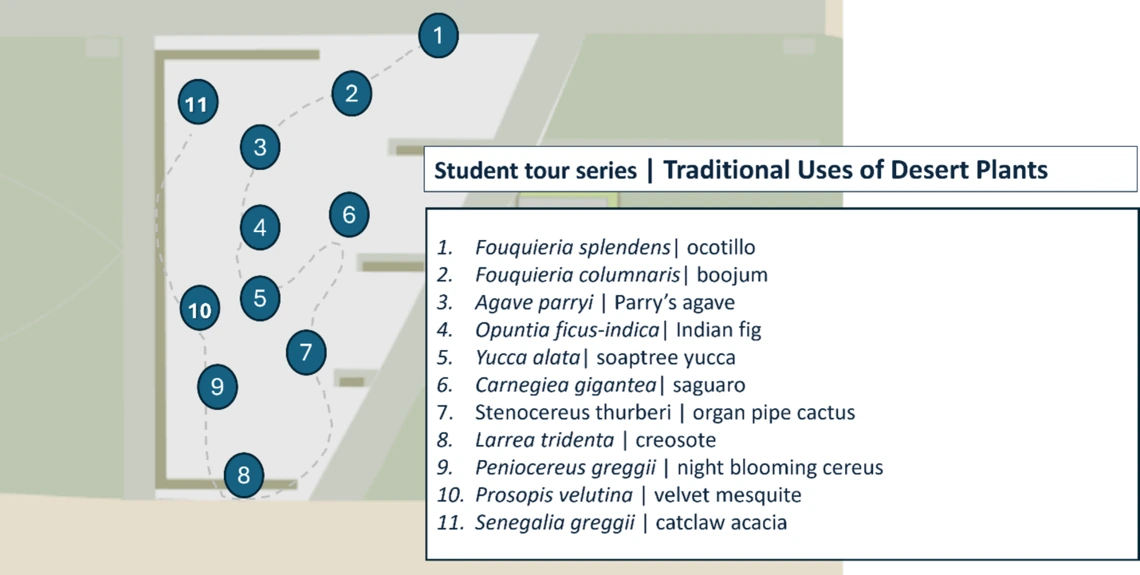
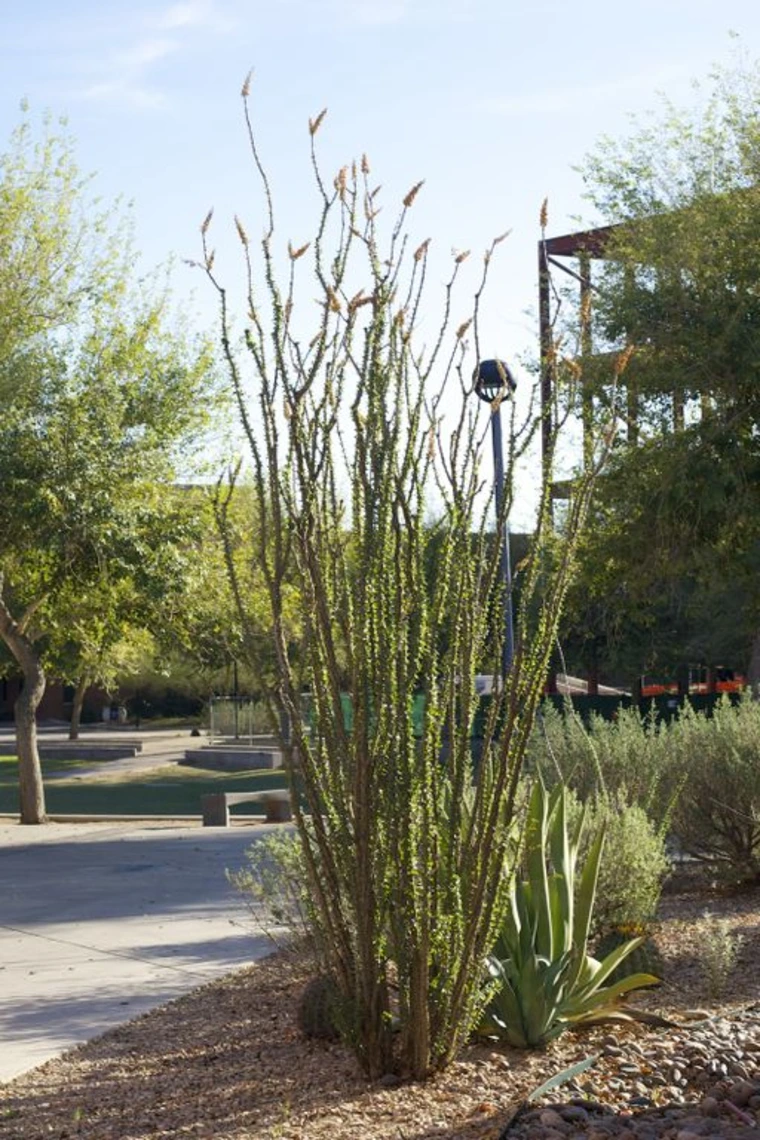
Our first stop is at the ocotillo. Ocotillo is a generally tall plant that looks like a cluster of spiny sticks sprouting from the center with bright red flowers at the tips. It is quite strange. Contrary to their cactus-like spiny appearance, the ocotillo is more closely related to blueberries and Brazil nut trees. People of the Cahuilla tribe of California, who known for their excellent hunting, gathering, agriculture, and basket weaving, used this plant as a food source, eating both its fruit and flowers. They also used the dried stems of this plant as a natural fence, for construction of houses and ramada roofs. People of the Apache tribe of Arizona, who were among the most successful nomadic communities due to their early adoption of and skill in riding horses, also consumed the fruit and flowers of this plant, and made use of the root of this plant to help reduce swelling and for washing.
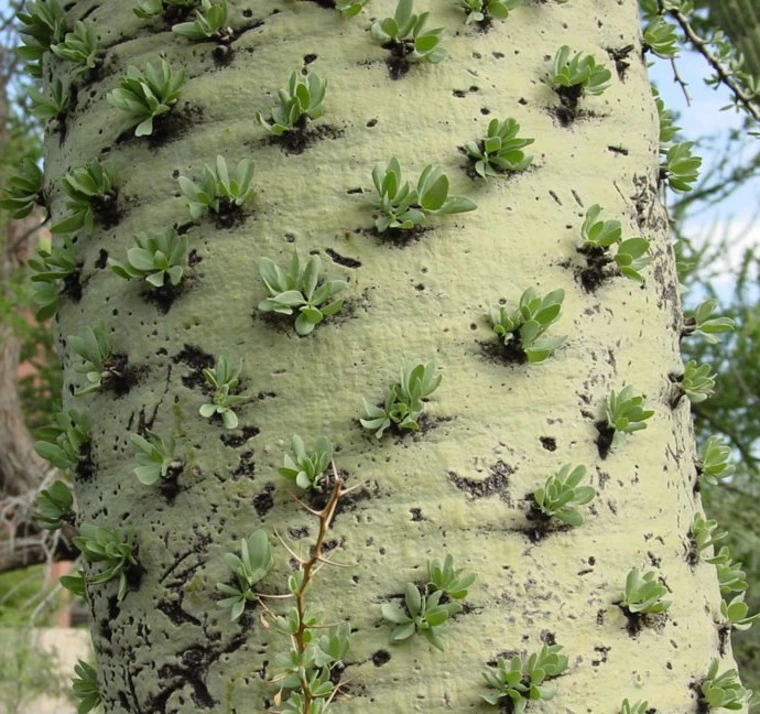
Our next stop will be at the boojum tree, a cousin of the ocotillo. With its thick trunk base and odd scattering of small stems, this is a truly strange looking plant. Larger specimens reach up to 70 feet tall, often with the same scattered branches, but sometimes with a more flowy, undulating trunk giving it a form that suggests it is blowing in the wind. The undulating growth habit is more common on boojum plants growing near the coast while the trunks of inland specimens usually maintain a more erect form. Unlike its cousin the ocotillo, this plant has not been as useful for human food, medicine, or construction. However, the plant has inspired stories and appears in folklore. The Seri, an indigenous group from Mexico famous for their fierce and prolonged resistance to Spanish attempts at acquisition of Mexico, believed touching this plant would cause strong, undesirable bursts of wind. Along with this oral tradition, the boojum provided literary inspiration a humorously nonsensical feature in Lewis Caroll’s poem “The Hunting of the Snark” which was written in 1876.
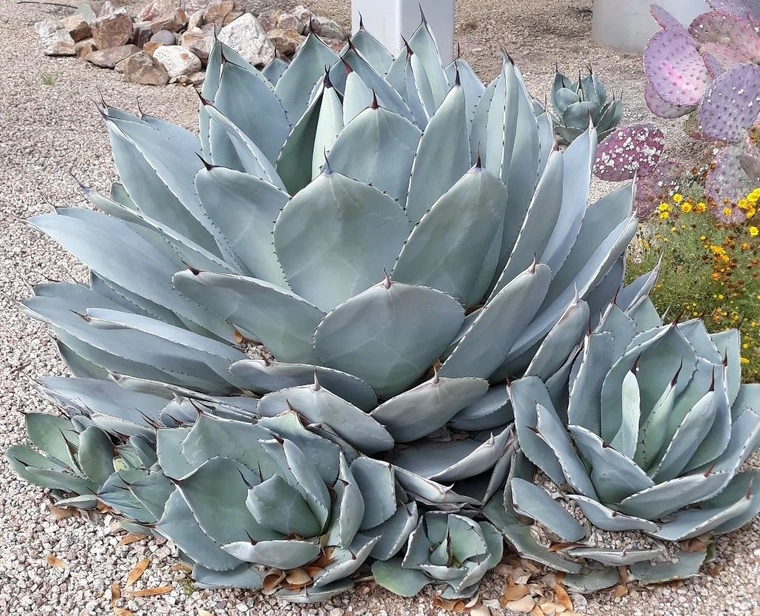
Next, we will move into the center of the garden to visit Parry’s agave, a rosette forming succulent with a form similar to other unrelated plants like aloe vera. Its color can vary between blue-gray to a green-gray, always appearing a little “dusty”. An adaptive trait of succulents like this is the development of terminal leaf spines, formed as the leaf tip is modified to protect the plant from predation. As this plant ages, it produces a tall flowering stock reaching several meters high. Parry’s agave dedicates so much energy to flowering and producing seeds from this stock, that it dies shortly afterwards. The people of the Apache tribe made great use of this plant. As a relative of the artichoke, the leaves and heart of agave can be eaten after being roasted or sun baked, the stalk can be eaten raw or baked and the flower stalk and agave heart can be fermented to produce alcohol. By modifying the usual fermentation process, honey can be produced as a treat and food sweetener, though it was also used as a thickener in natural paints. Agave is also used as a textile material, much like leather, being used for making sandals, nets, and blankets. The stalk has been used to make a musical instrument called Tsii Edo’ Ai or the Apache fiddle, by hollowing it out and allowing it to dry. This instrument was used to play music ceremonially and for social enjoyment.
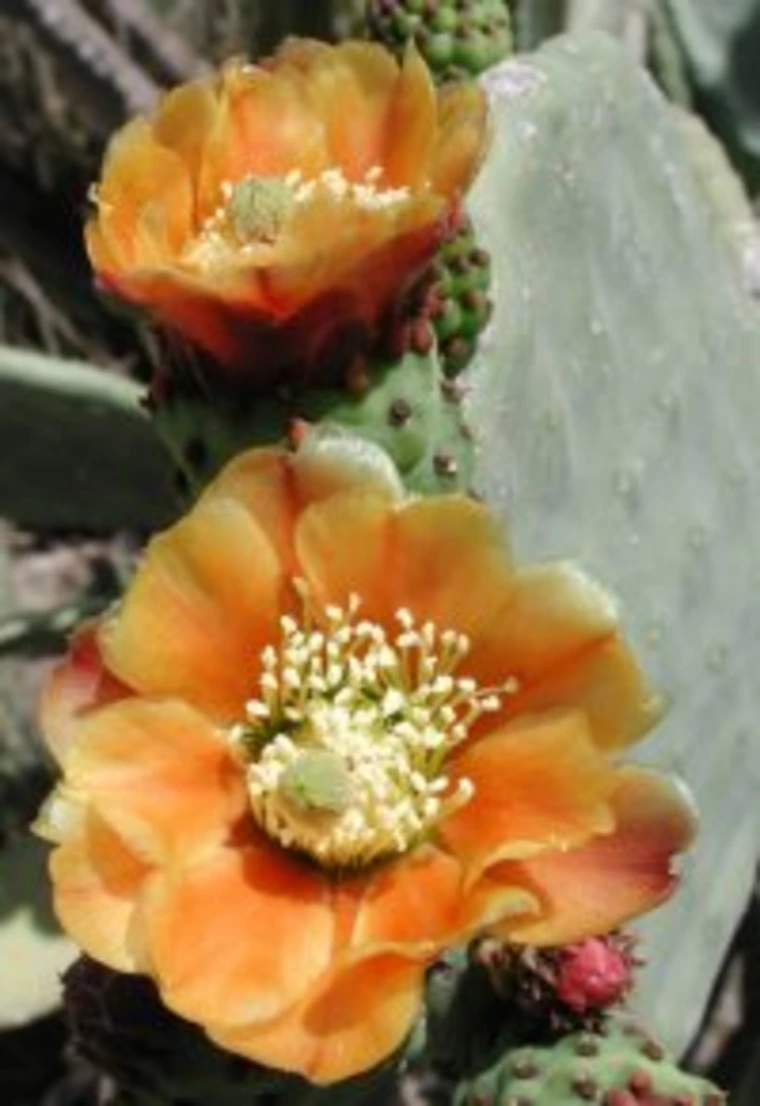
Nestled a little deeper in the Krutch garden, we can visit an incredible member of the prickly pear family, the Indian fig. This plant can grow quite large, reaching heights of 5 meters (15 ft) and 3 meters (10 ft) wide. As you can see, this plant produces succulent, flat, pale olive green green pads covered with spines. Locals call these modified leaves, “nopales” or “nopalitos”. In addition to the interesting, large fleshy pads, this cactus also produces impressive vibrant orange or yellow flowers in late spring to early summer. The pads and fruits are both edible. The pads are best eaten early in the season, when they are young. Many remove the spines and glochids, eat them as one might do with any vegetables, raw, or after boiling or frying. I personally enjoy them with scrambled eggs. The pads are not only edible but confer health benefits such as lowering blood sugar and, with time, lowering cholesterol. The fruits, called “tunas” in other regions, are usually sweet and eaten raw or prepared as jams and candy. The pulp from the pads can be used as a topical treatment as well, as a sunscreen, moisturizer and even wart remover. The Indian fig has been utilized by many notable tribes for survival, one of them being the Cherokee. Being one of the largest North American communities in all of the U.S the Cherokee are best known for their ability to produce crafts such as pots, wood carvings, and baskets. They are also appreciated for their unique use of syllabary, a complex set of symbols representing syllables, in their writing system.
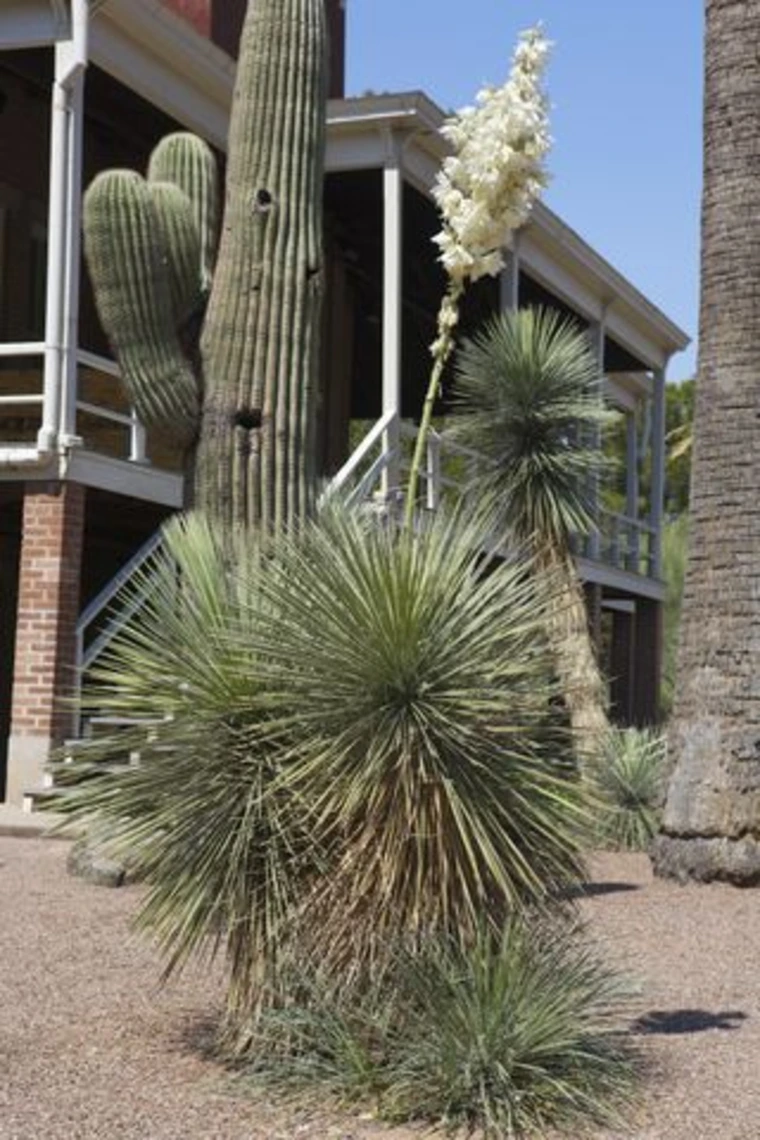
The next plant we will get to know is the soap tree yucca, a drought tolerant succulent. It has a trunk that resembles wood, fibrous leaves, and beautiful white, bell shaped flowers. While what you see above ground is fascinating, below ground you will find impressive thick underground stems called rhizomes that can reach depths of 3-5 feet. As this plant's name goes, the soap tree yucca is used to produce soap. The roots of this plant, when peeled, pounded, and mixed with water release the plant’s saponins, organic compounds found in the plants that lather when mixed with water and which also help fight off infection and pests. This soap is used for general hygiene but also for ceremonial washing wherein the participants view the lather as a means to purify an individual's negative energy. This plant is utilized by many tribes including the Tewa, Navajo, Ute, Tohono O'odham and Apache. The roots are considered extremely bitter tasting by some while the flavor is considered delicious by the people of the Apache and Tohono O’odham. The leaves of this plant are used to create textiles that can then be made into mats, sandals, and clothing.
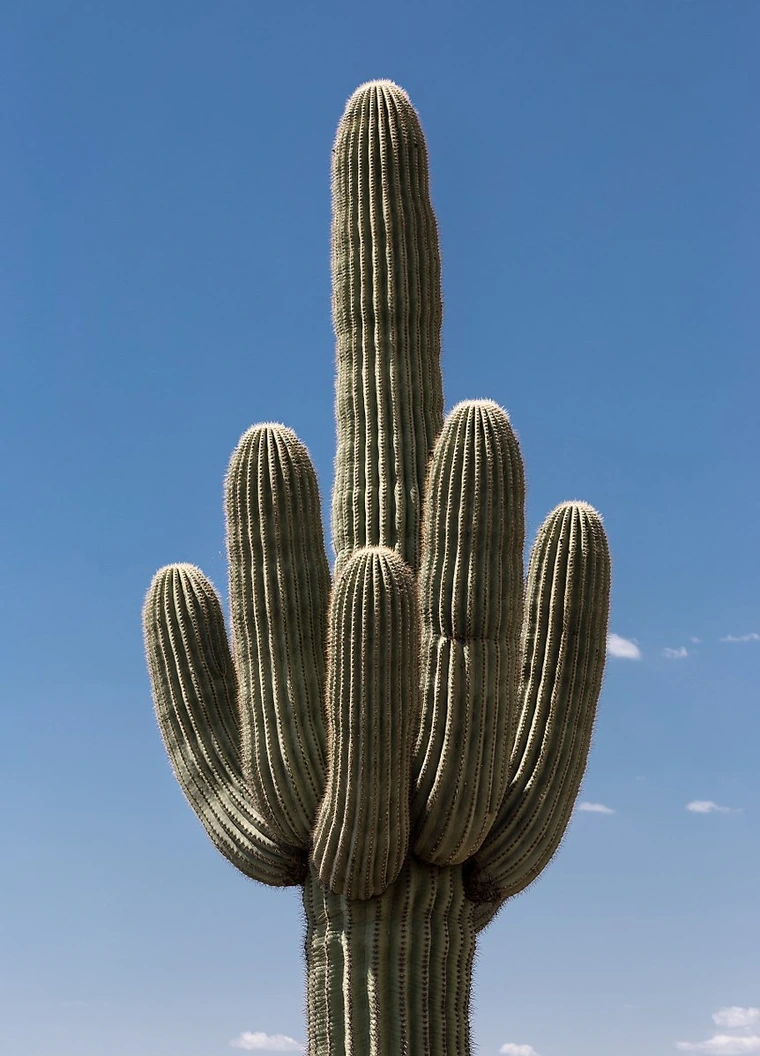
On the outside of edge of the garden, on the east side, we can see the mighty saguaro. As you walk carefully in that direction to the south, you’ll first pass the cardon, a cousin of the saguaro distinguished by its more grey-green coloration and its tendency to sprout arms lower on the trunk. Saguaro, which is a tree-like cactus endemic to the Sonoran desert, can reach up to 20 meters (50 ft) tall, doesn't start sprouting arms until after its 50th birthday. It has time to wait, as it is a very slow growing and long lived cactus, often living 150-200 years. To survive in an arid desert environment, the saguaro cactus has pleated folds in its succulent body that expand to allow water storage during the rainy season and a shallow root system that spreads outwardly just under the soil surface to best catch water from even a light sprinkle of rain. The fruit can be eaten raw, made into a jam, wine, and syrup. It is so central to life in the desert, that native communities developed a calendar systems around the saguaro fruiting season and used the wine made from saguaro fruit to celebrate the coming monsoon. Folklore associated with saguaro encourages those who eat the fruit to discard the fruit’s peel facing upward, as this was believed to encourage rainfall. Animals in the desert also benefit from the saguaro. Can you see any holes on the saguaro in this garden? Often birds like the Gila woodpecker create these cavities to use for nesting. When these holes are made, the saguaro responds by scabbing over the wound, secreting a glue like substance which eventually produces a hard coating, called a ”saguaro boot”. When the plant dies, these saguaro boots, have been collected and used to carry and store water by the Seri people. Currently, it is illegal to collect saguaro boots from the wild.
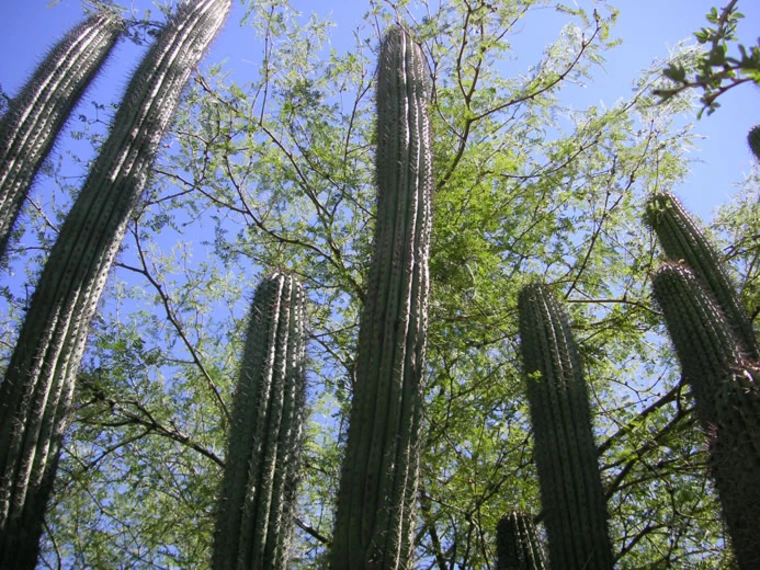
Best known for its organ pipe-like structure, we will now enter into the garden near the south end of the garden. Facing west, you will see a massive organ pipe cactus. The plant sports an olive green skin, covered with fine and dense spines on arms reaching 10 meters (30 ft). The organ pipe cactus is also known for its flowers, which are pink-ish red with white edges and appear at night. This plant was utilized for its sweet-tasting fruit by the Tohono O'odham. Like the Saguaro, this plant's fruit was also used ceremoniously to celebrate the harvest season. While delicious, the flesh of the fruit is also used to help with toothaches, and to ease snake bites. The seeds of these fruits can be dried, grinded, and turned into flour. The skeleton or ribs of this plant, when fully dry, can be utilized in home construction, as ceiling beams and fences.
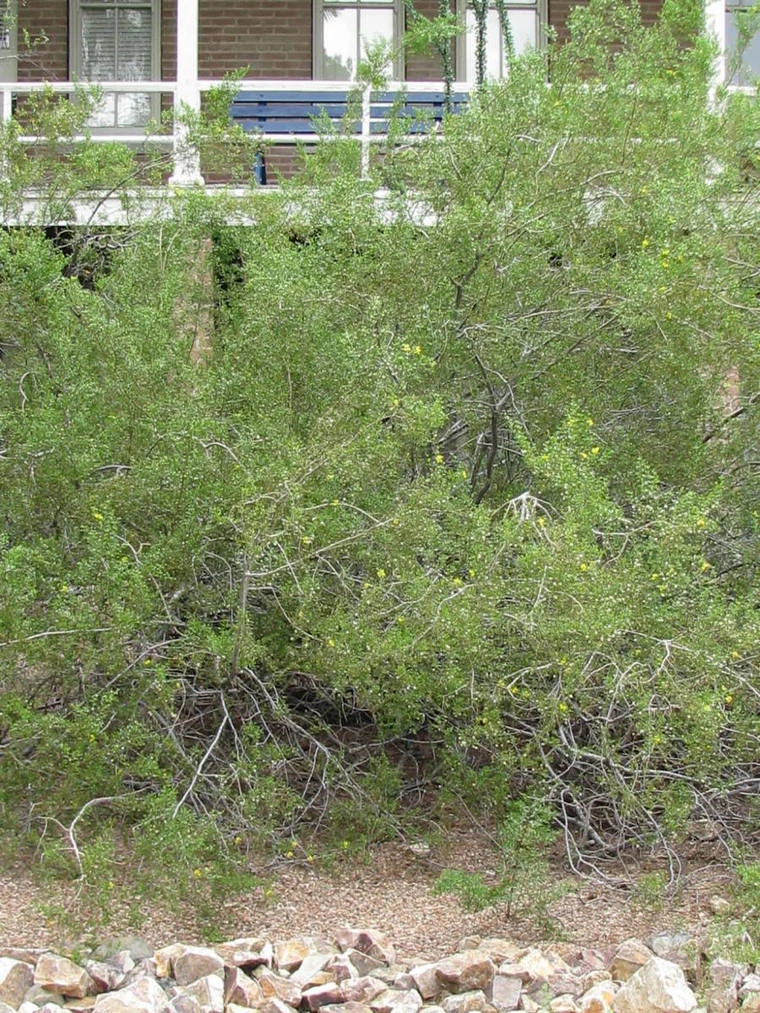
The creosote is a medium sized bush with green, resinous leaves, bright yellow flowers, and white fluffy seed capsules. This plant is notable for its strong and unique odor, often filling the air during the rainy season. Unlike many of the other plants on this tour, the creosote has no edible parts, all of which are toxic upon consumption. However, the twigs can be boiled and made into a tea used in treating pain, colds, coughs and fevers. Commercially, the tea is sold under the name “chaparral tea”. Creosote can used topically to treat a variety of ailments such as cuts, skin abrasions, dandruff and other skin irritations. Topical applications are prepared by mashing, drying and grinding the stems into powder later for later use in infusions. Similarly, this preparation method is used as a paste used to clean and polish teeth and to alleviate toothache. The Akimel O'odham or Pima peoples, valued the creosote for these uses. The tribal name “Pima” was given to them by the Spanish colonists through their verbal interactions. When interacting, the Akimel O’odham would often respond with "pi \'añi mac" or "pi mac" which translates to “I don’t know”, and the spanish misinterpreted this as their name. The Akimel O'odham will still refer to themselves by their original name, which in their language means “people of the river”. One of my favorite uses of the creosote, utilized by many tribes and my great grandmother, is as a foot deodorizer. Growing up, I had gone through the smelly foot phase like most kids my age, and my grandmother knew immediately how to fix it, by sprinkling gathered leaves of the creosote bush into my shoes. The result proved effective, even with my socks stained green.
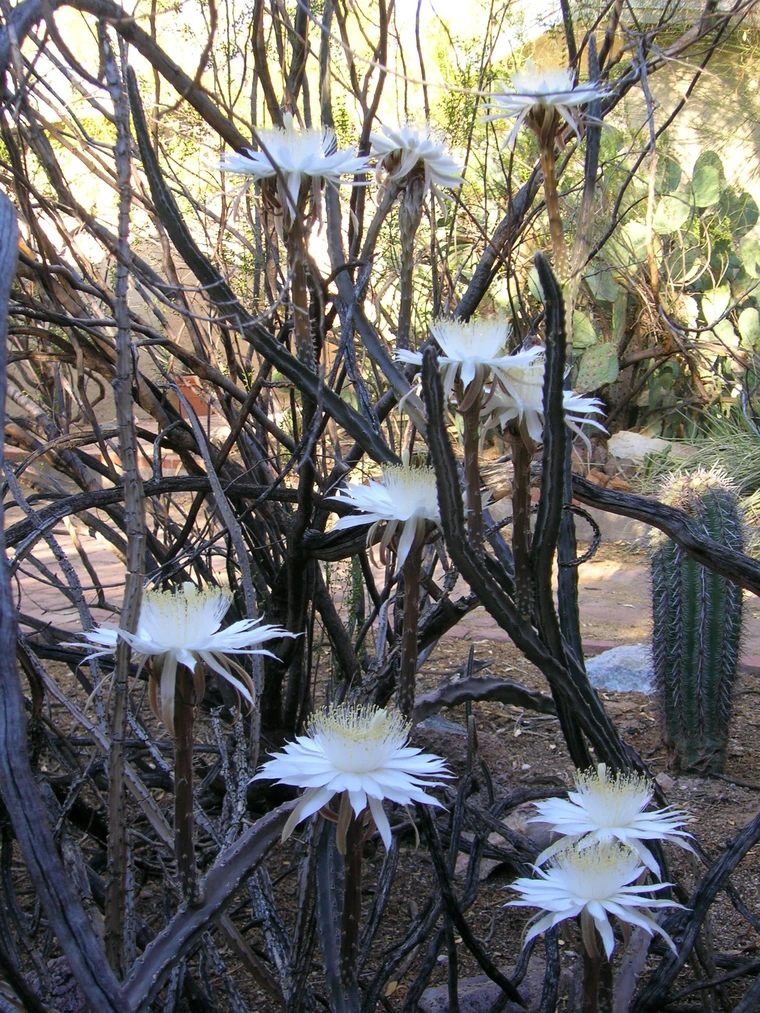
Our next plant is the night-blooming cereus. As its name implies, this plant has magnificent white flowers that bloom at night and remain open all through the night until dawn. These flowers can get quite big, reaching sizes up to a 1/3 meter (1 ft) long. This plant often varies in size, and form as it is is able to grow as a vine, climber, or with a more upright habit. The stems of this plant are dark olive green and covered with short spines arranged in vertical rows. The Pima used this plant medicinally to treat respiratory issues, headaches, and stomach issues by boiling it and taking it orally. All of this plant including the flower, stem, young pads, and fruits are used as a food source by many indigenous communities. The blooming period was significant ceremonially but the waiting and watching for the nightly blooms is still highly anticipated by communities of people in the Sonoran desert in June and July.
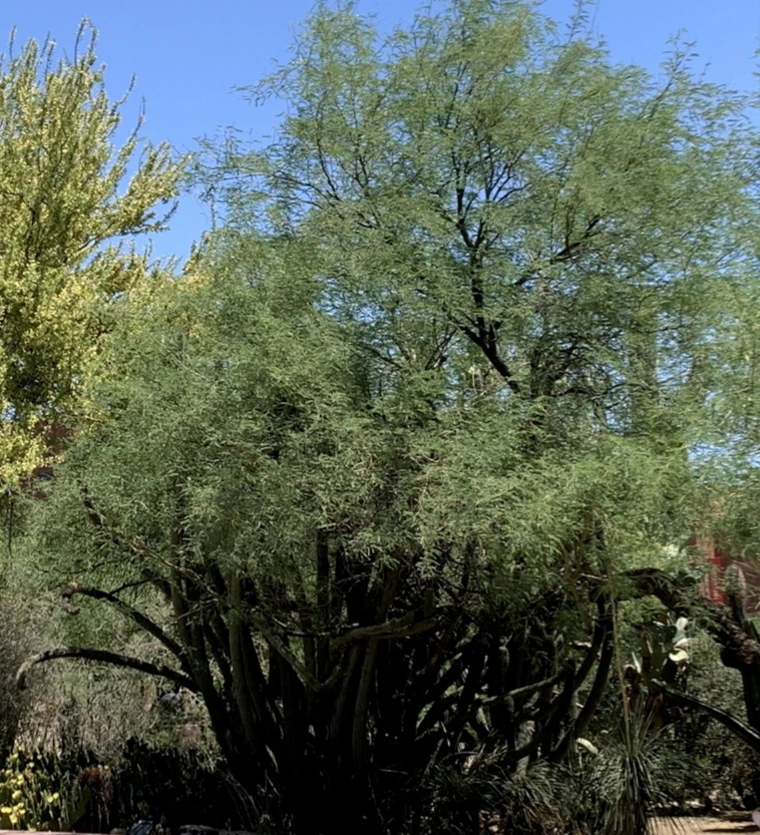
The velvet mesquite is notable for its ability to survive the harsh conditions of the Sonoran desert. As a winter deciduous tree, the velvet mesquite will lose its leaves during the winter. The leaves are fern-like in appearance and covered in short, thin hairs. These hairs are what give it its velvet-like appearances. The velvet mesquite is also a member of the legume family, which produce protein rich seeds in pods. You may be familiar with edible legumes such as beans, peas and green beans, which are the mesquite’s cousins. The tree is used as a food source by making flour from ground, dried seeds, by eating the seeds raw, or by making mesquite honey as a flavor additive. The gum of this plant can be made into candy, pottery glue, and black die. Production of tree gum is a defensive strategy when the tree is harmed, that allows wounds to heal over. The sap of this tree can also be consumed and helps with colds. The root and bark of this tree can be ground or chewed to help with conjunctivitis and intestinal parasites. Topically, it can help with acne, and dandruff. The Tohono O’odham used this plant as an integral part of their culture, trading resources from this plant with other tribes and using the wood of this tree as lumber, baskets, and fabrics.
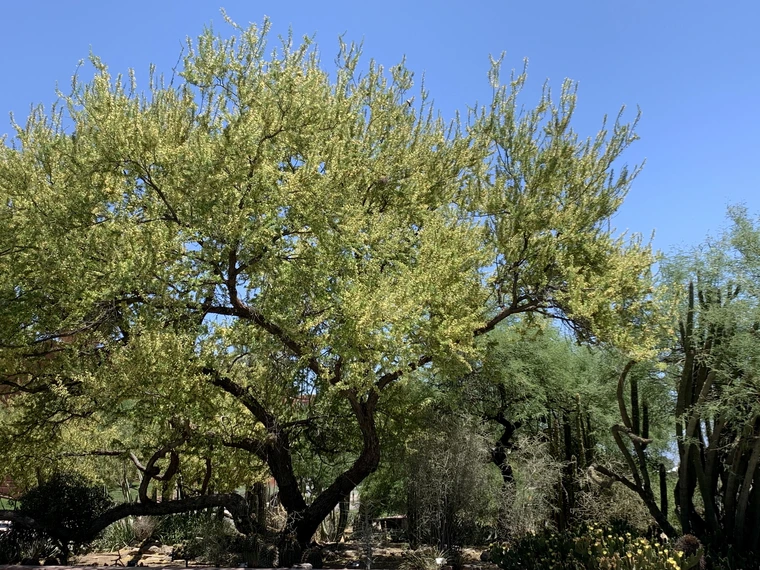
Our last stop is the catclaw acacia, which is typically considered a large shrub and short tree. This plant can be seen nearly all over Tucson, recognized for its spreading nature. The name catclaw comes from its curved spines found at the stem nodes along the length of its branches. The leaves can vary from a bright to faded green and its flowers are creamy white and arranged in an inflorescence that creates fragrant, fluffy cylinders dangling from the branches during late spring. Similarly to the velvet mesquite, the catclaw acacia is a member of the legume family and also produces its seeds in pods. Small twigs and leaves of this tree can be made into a tea that helps alleviate stomach and kidney problems. When mixed with water, the leaves can be made into a meal that can be used to bake bread and cake. The flowers of this plant can be utilized to make perfumes with a sweet smelling aroma. The wood of this tree was used for fire fuel, furniture, and even fishing. The Seri and Yachi tribes used these tree branches to create bows.
This concludes the plant-thropology tour. I hope you enjoyed and found valuable information from this tour for the next time you see any of our native plants we share the desert with.
This tour was created as part of an arboretum work study program in Spring 2025 by undergraduate student AJ Vasquez, who was pursuing a B.S. degree in Ecology and Evolutionary Biology, College of Science, with a minor in Anthropology, College of Social and Behavioral Sciences. It incorporates information from the arboretum’s Sonoran Native Plants tour and AJ’s personal and family experiences with the Sonoran native plants included in this tour.
University of Arizona, Class of 2027


